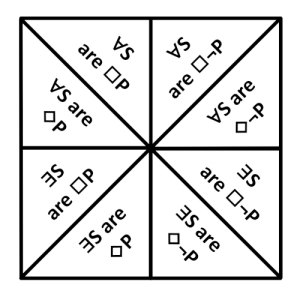 Medieval logician John (or Jean) Buridan was a scholar of Aristotle, and wrote many works of commentary and elaboration on Aristotelian philosophy. Several items in logic and philosophy are tied to Buridan (such as Buridan’s Bridge and Buridan’s Ass) but he may now be more widely known for his Octagon which combines Aristotle’s Square of Opposition with a Square of Modality.
Medieval logician John (or Jean) Buridan was a scholar of Aristotle, and wrote many works of commentary and elaboration on Aristotelian philosophy. Several items in logic and philosophy are tied to Buridan (such as Buridan’s Bridge and Buridan’s Ass) but he may now be more widely known for his Octagon which combines Aristotle’s Square of Opposition with a Square of Modality.
Below and to the right is a fourfold diagram of Aristotle’s Square of Opposition. The modern universal and existential (or particular) qualifiers are ∀ (meaning All) and ∃ (meaning Some), respectively. Also in these diagrams, ¬ means logical Not.
Next I show a fourfold of modal operators and their equivalents. The modern modal symbols are □ (meaning Necessarily) and ◇ or ◊ (meaning Possibly).
Further Reading:
https://en.wikipedia.org/wiki/Jean_Buridan
https://plato.stanford.edu/entries/buridan/
https://plato.stanford.edu/entries/medieval-syllogism/#JohnBuri
https://en.wikipedia.org/wiki/Modal_logic
https://plato.stanford.edu/entries/logic-modal/
https://plato.stanford.edu/entries/modality-varieties/
https://lirias.kuleuven.be/retrieve/517366
Click to access Demey_DWMC2015_Buridan_Avicenna_slides.pdf
Click to access Buridan_Octagon.pdf
Click to access hughes-buridan.pdf
https://en.wikipedia.org/wiki/Buridan%27s_ass
https://en.wikipedia.org/wiki/Buridan%27s_bridge
https://en.wikipedia.org/wiki/Buridan_formula
[*12.144]
<>


